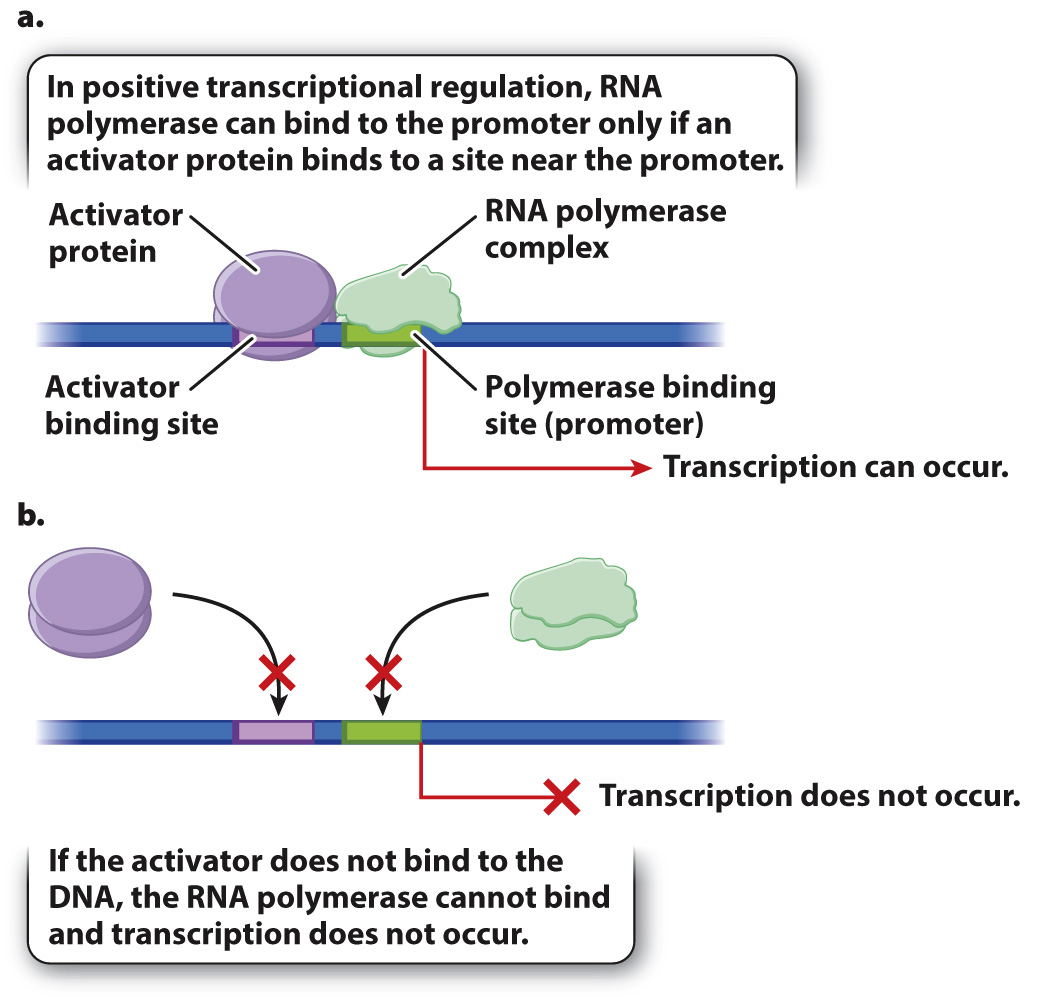Transcriptional regulation can be positive or negative.
387
In both eukaryotes and prokaryotes, transcription can be positively or negatively regulated. In positive regulation, a regulatory molecule (usually a protein) must bind to the DNA at a site near the gene in order for transcription to take place. In negative regulation, a regulatory molecule (again, usually a protein) must bind to the DNA at a site near the gene in order for transcription to be prevented. Most promoters contain one or more short sequences that function to help recruit the proteins needed for transcription when transcription of the gene is activated. In eukaryotes, many promoters contain the sequence 5′-TATAAA-
Fig. 19.12 illustrates positive regulation. The main players are DNA, the RNA polymerase complex, and a regulatory protein called a transcriptional activator. As shown in Fig. 19.12a, when the activator protein is present in a state that can interact with its binding site in the DNA, the RNA polymerase complex is recruited to the promoter of the gene and transcription takes place. When the activator is not present, or not able to bind with the DNA (Fig. 19.12b), the RNA polymerase is not recruited to the promoter and transcription does not occur. The binding site for the activator may be upstream of the promoter, as shown in the figure, be downstream of the promoter, or even overlap the promoter.

Sometimes, the activator protein combines with a small molecule in the cell and undergoes a change in shape that alters its binding affinity for DNA. The change in shape is an example of an allosteric effect (Chapter 6). In some cases, the activator cannot bind with DNA on its own, but combining with the small molecule changes its shape and its ability to bind with particular sequences in the DNA. The presence of the small molecule in the cell therefore results in transcription of the gene. Genes subject to this type of positive control typically encode proteins needed only when the small molecule is present in the cell. For example, in E. coli, the genes for the breakdown of the sugar arabinose are normally repressed in the absence of the sugar because a regulatory protein binds the DNA in such a way as to prevent transcription. In the presence of arabinose, however, the shape of the protein is altered so that it binds a different site in the DNA, allowing transcription of the genes. For other genes, activator proteins can bind DNA only when a small molecule is absent from the cell. These genes typically encode proteins needed for synthesis of the small molecule. In E. coli, the genes for synthesis of the amino acid cysteine are regulated in this fashion.

Fig. 19.13 illustrates negative regulation. In this case, the DNA in its native state can recruit the RNA polymerase complex, and transcription takes place at a constant rate unless something turns it off (Fig. 19.13a). What turns it off is binding with a protein called a repressor (Fig. 19.13b). Again, the binding site for the repressor can be upstream of the promoter, downstream of the promoter, or overlapping with the promoter.
388
As with positive control, the ability of the repressor to bind DNA is often determined by an allosteric interaction with a small molecule. A small molecule that interacts with the repressor and prevents it from binding DNA is called an inducer. In the next section, we will look closely at the regulation of genes for the breakdown of the sugar lactose in E. coli, and we will see that a derivative of lactose binds to and inhibits the repressor and is therefore an inducer of these genes.
In other cases, the small molecule changes the conformation of the repressor so that it can bind to the repressor binding site and inhibit transcription. Genes regulated in this way are often needed for synthesis of the small molecule. In E. coli, for example, the genes for the synthesis of the amino acid tryptophan are negatively regulated by tryptophan. When tryptophan is present in sufficient amounts, it binds with a regulatory protein to form the functional repressor, and transcription of the genes does not occur. When the level of tryptophan drops too low to form the repressor, transcription of the genes is initiated.
Quick Check 3 Explain how the ability of a large, multisubunit protein molecule to bind a specific DNA sequence can be altered when it binds with a small molecule no larger than a single amino acid.
Quick Check 3 Answer
Binding with the small molecule results in a conformational change in one part of the protein that initiates a chain of interactions that propagate and alter its structure at sites far removed from the small molecule. These changes may conceal amino acid side chains responsible for the original DNA-